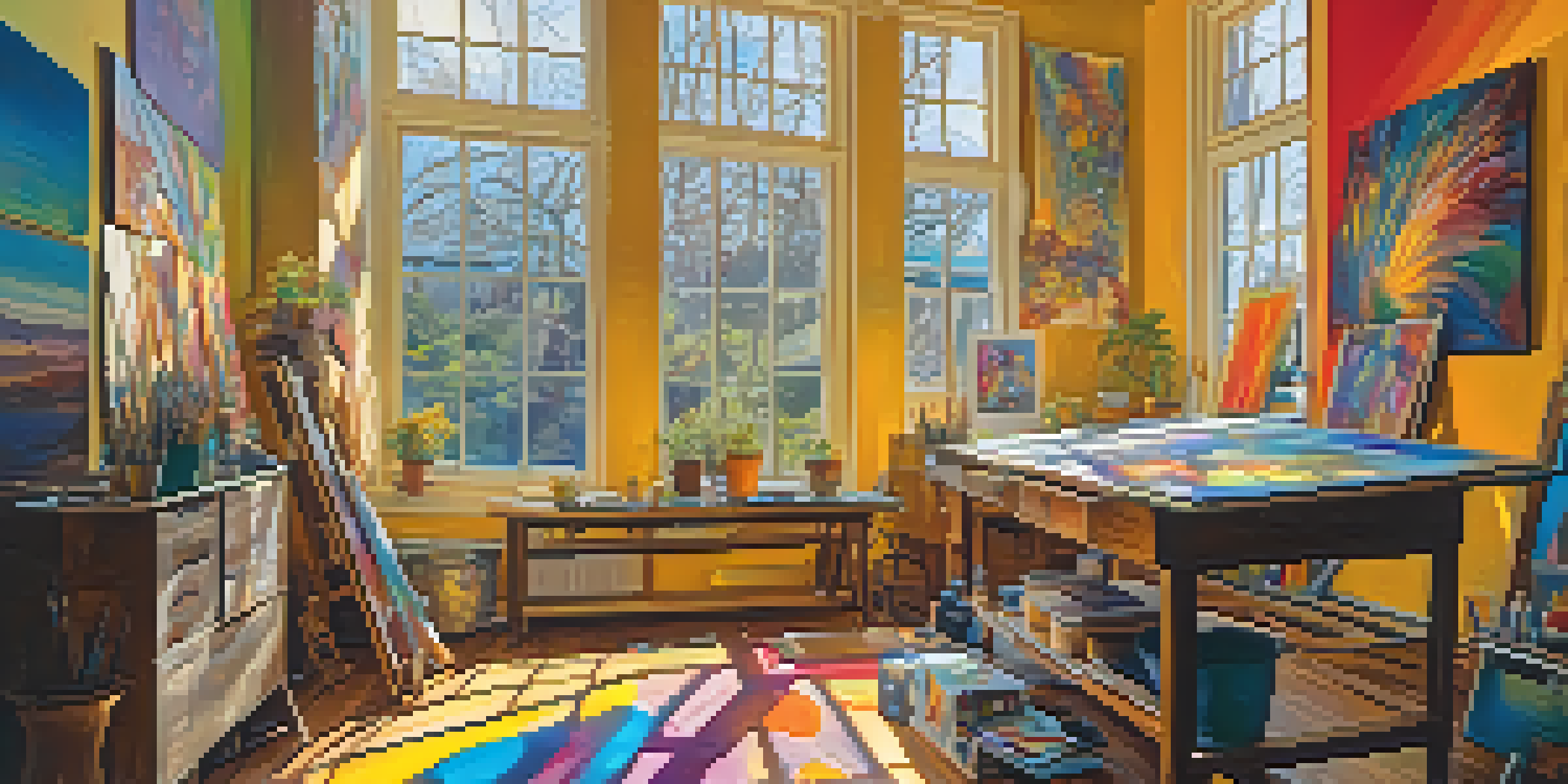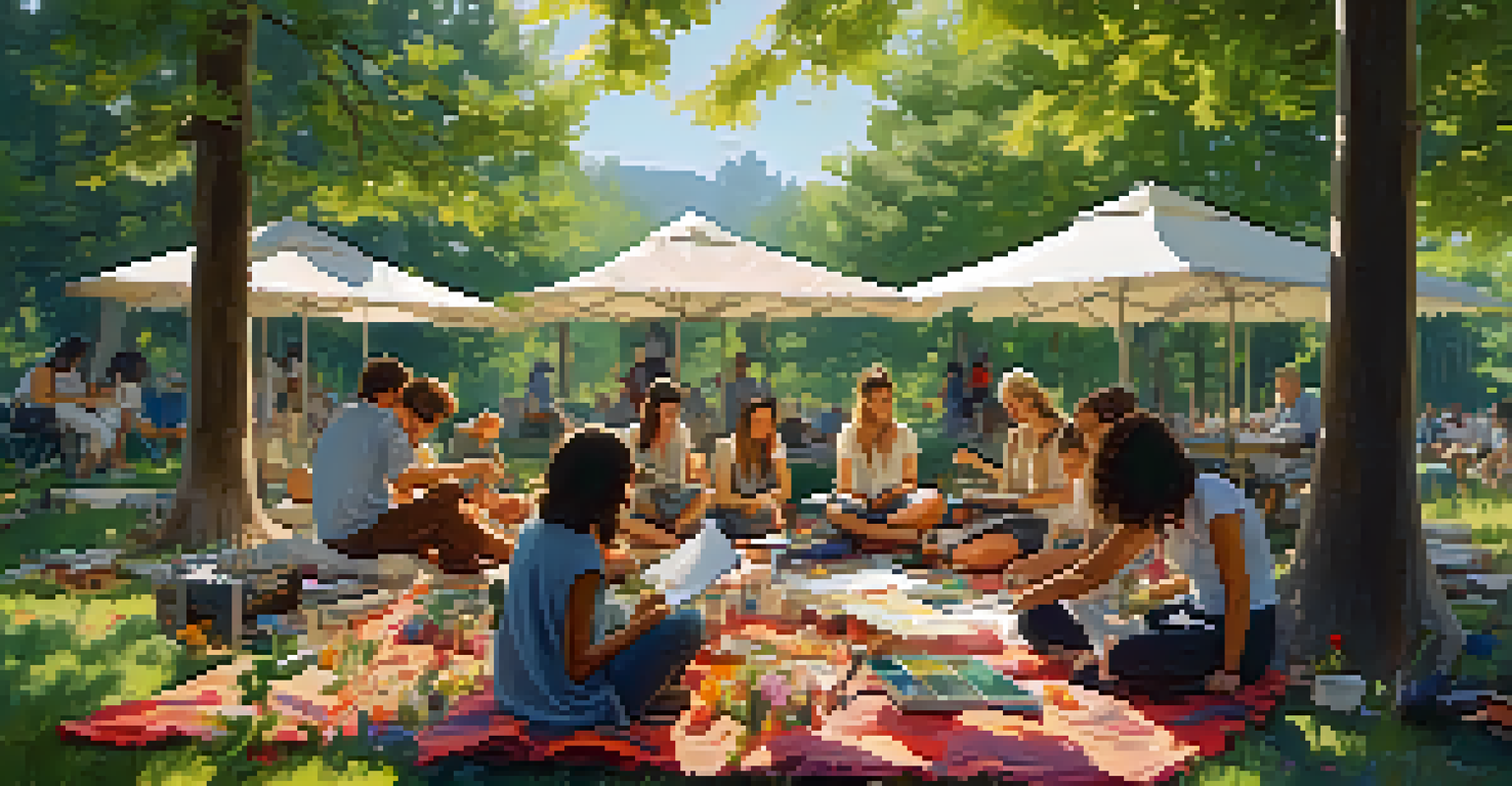The Impact of Psychedelics on Modern Creative Practices

Understanding Psychedelics and Their History in Art
Psychedelics, substances that alter perception and cognition, have long been associated with creative practices. Artists and thinkers from the Beat Generation to the modern era have turned to these substances for inspiration. Notably, figures like Aldous Huxley and the band The Beatles explored altered states of consciousness to enhance their artistic output.
Psychedelics are powerful tools for exploring creativity and unlocking new dimensions of artistic expression.
Historically, psychedelics like LSD and psilocybin have been used in various cultures for spiritual and creative purposes. They often lead to profound experiences that can help individuals see the world through a different lens. This shift in perception can spark innovative ideas, breaking the boundaries of conventional thought.
As we delve into the relationship between psychedelics and creativity, it’s essential to recognize how these substances can facilitate a deeper connection to one’s artistic self. This connection can lead to new forms of expression that resonate with audiences on multiple levels.
The Science Behind Psychedelics and Creativity
Recent studies suggest that psychedelics can enhance creative thinking by promoting neuroplasticity—the brain's ability to reorganize itself. This increased flexibility allows individuals to make novel connections between seemingly unrelated ideas, a crucial aspect of the creative process. For example, researchers have noted enhanced divergent thinking, which is the ability to generate multiple solutions to a problem, after psychedelic use.

Additionally, psychedelics can reduce the activity of the default mode network (DMN), the part of the brain responsible for self-referential thoughts. By quieting this network, users may experience a decrease in the inner critic, allowing for freer expression of ideas. This can lead to a more spontaneous and uninhibited creative process.
Psychedelics Enhance Creativity
These substances can promote neuroplasticity and reduce self-referential thoughts, leading to new connections and innovative ideas.
However, it’s important to approach these substances with caution and respect. While they can unlock new dimensions of creativity, they also come with risks, including potential negative psychological effects. Balancing exploration with safe practices is key to harnessing their creative potential.
Psychedelics in Contemporary Artistic Communities
In recent years, a growing number of artists and creative professionals have openly discussed their use of psychedelics as a tool for inspiration. From visual artists to writers and musicians, many credit these substances with helping them break through creative blocks. For instance, renowned filmmaker Michelle Gondry has spoken about how psychedelics have influenced his unique storytelling style.
The creative process often involves a journey into the unknown, where psychedelics can serve as a guide.
Moreover, creative workshops and retreats centered around psychedelic experiences are becoming more popular. These gatherings often focus on combining guided psychedelic experiences with artistic expression, allowing participants to explore their creativity in a supportive environment. This trend highlights a collective desire to integrate these substances into the creative process.
As the stigma surrounding psychedelics diminishes, more artists are willing to share their experiences and the positive impact these substances have had on their work. This shift signals a broader acceptance of alternative methods for enhancing creativity and pushing artistic boundaries.
Psychedelics and the Flow State
Many artists report experiencing a 'flow state' while under the influence of psychedelics, a condition where they feel fully immersed and engaged in their creative work. This state of heightened focus often leads to remarkable productivity and innovation. Similar to athletes reaching peak performance, artists in this state can produce their best work, often with a sense of ease and joy.
The flow state is characterized by a loss of self-consciousness and a deep connection to the task at hand. Psychedelics can facilitate this experience by diminishing the inner critic and allowing the artist to explore their creativity without fear of judgment. This liberation can lead to breakthrough moments that redefine an artist's body of work.
Growing Acceptance in Art
As stigma fades, more artists are openly discussing their use of psychedelics as a tool for overcoming creative blocks.
However, achieving a flow state through psychedelics isn't guaranteed for everyone. Individual responses to these substances can vary widely, so it’s crucial for artists to find what works best for them, whether that's through psychedelics or other creative practices.
Ethical Considerations in Psychedelic Use
As with any powerful tool, the use of psychedelics in creative practices raises ethical questions. It's essential to consider the implications of using substances that can profoundly alter one's consciousness. For instance, the potential for misuse or dependency can overshadow the benefits, especially in a culture that often glamorizes drug use.
Moreover, the context in which psychedelics are used is crucial. Engaging in psychedelic experiences without proper guidance or support can lead to negative outcomes, both psychologically and creatively. This highlights the importance of education and responsible use, emphasizing the need for informed choices.
Ultimately, the conversation around psychedelics in creative practices must include discussions about safety, legality, and the potential for both positive and negative experiences. By approaching these substances with mindfulness and respect, artists can navigate their creative journeys more effectively.
Psychedelics and Mental Health in Creativity
Beyond enhancing creativity, psychedelics have gained attention for their potential therapeutic benefits, particularly for mental health. Many artists struggle with mental health issues, and some have turned to psychedelics as a means of healing. Emerging research suggests that psychedelics can provide insights and emotional breakthroughs that facilitate personal growth and recovery.
For instance, studies have shown that psychedelics can help alleviate symptoms of depression and anxiety, conditions that often plague creative individuals. By addressing these underlying issues, artists can find renewed energy and inspiration in their work. This therapeutic aspect intertwines with the creative process, as healing can lead to profound artistic expression.
Potential Mental Health Benefits
Psychedelics may provide therapeutic effects, helping artists address mental health issues and find renewed inspiration in their work.
However, it's essential to approach this aspect with caution. Not all individuals will have the same experiences with psychedelics, and for some, it may exacerbate existing mental health issues. Ongoing research and dialogue are vital to ensure that the use of psychedelics in creative contexts is both safe and beneficial.
Future Perspectives: Psychedelics in Creative Industries
Looking ahead, the integration of psychedelics into creative industries appears to be on the rise. With ongoing research and changing societal attitudes, we may see a shift in how these substances are perceived within professional settings. As companies and organizations explore innovative ways to enhance creativity, psychedelics could become a part of the conversation.
Workplace wellness programs that incorporate psychedelics for creativity and mental health support are already being discussed in some creative fields. This could lead to more open dialogues about mental health, creativity, and the tools that can support them. The potential for psychedelics to enhance collaboration and ideation in team environments is an exciting prospect.

As we continue to explore the impact of psychedelics on modern creative practices, it’s crucial to foster a culture of responsibility and safety. Educating individuals and organizations about the benefits and risks will ensure that the exploration of psychedelics enhances creativity without compromising well-being.